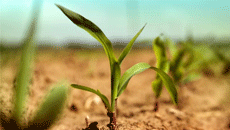
A brief survey among Grain SA Executive members on the planting progress of summer grains indicate that rain is eagerly awaited in most areas.
Producers in the Eastern parts (KZN, Mpumalanga and Eastern Free State) of the country’s optimum planting time for maize range from mid-October to mid-November. Feedback from Grain SA’s Executive indicated that maize plantings in Mpumalanga are almost completed and they are currently busy with soybean plantings. It is dry in some areas and rain is not only needed on the already planted seedlings, but also to complete the planting process.
With minimal plantings to date in the Eastern Free State, the optimal plant window for maize is running out. Generally, minimal hectares of summer crops were planted, with the exception of areas where producers could plant here and there due to better soil moisture. Conditions are currently very dry; widespread rain is critically needed before producers can plant in earnest. Planting in the area should occur somewhat later than normal and possibly outside the optimal planting window.
Producers in the Western parts (North West Central Free State and North West Province) of the country’s optimum planting time for maize starts around mid-November and extend over a month to mid-December. Conditions in the area are generally very dry. Although a large percentage of land preparations have been completed, some producers are awaiting rain to complete soil preparation. Cotton has already been planted on a small scale, while almost no summer plantings have been done to date. Rain is awaited before producers will start planting. Planting maize under irrigation has started though.
In Limpopo (Springbokvlakte-area) it is very dry and no dryland summer grains have been planted. There is still time till almost end-November for maize plantings. Approximately 50% of land under irrigation have been planted.
Early maize in the Northern Cape has been planted with minimal groundnut hectares. There is an expansion in cotton-hectares, with feedback indicating that cotton is generally struggling to germinate. In Limpopo, problems are also being experienced with cotton, with a lot of hail damage on the early cotton. Expectation of a decrease in maize and soybean hectares planted, has been reported.
Following nearly two years of talks and various analysis, the Wheat Forum reached consensus on the grading of wheat. The change proposed in the forum is as follows:
Table 1: Wheat grading
|
Grade |
*Min Protein |
HLM |
Falling number |
|
Super |
12,5% |
76kg |
250 seconds (30 deviation) |
|
B1 |
11,5% |
76kg |
250 seconds (30 deviation) |
|
B2 |
10,5% |
76kg |
250 seconds (30 deviation) |
|
B3 |
9,5% |
74kg |
250 seconds (30 deviation) |
*12% moisture
Part and partial of the conversation regarding the grading, was the price differences between different grades. Here, consensus was reached within the forum on the following:
Table 2: Price differences between grades
|
Grade |
Min Protein |
Price difference |
|
Super |
12,5% |
+2% |
|
B1 |
11,5% |
Base |
|
B2 |
10,5% |
-1% |
|
B3 |
9,5% |
-4% |
This indicate the JSE-traded price will be a B1 and thus, form the basis. The super grade will be at a base + 2%, B2 will be base -1% and B3 will be base - 4%.
Table 3: Summary of grading and price differences
|
Current Grading |
|
New Grading suggestion |
||||||||
|
Grade |
Protein |
HLM |
Falling number |
*Price difference |
|
Grade |
Protein |
HLM |
Falling number |
Price difference |
|
|
|
|
|
|
|
Super |
12.5% |
76kg |
250 sec |
+2% |
|
B1 |
12% |
77kg |
250 sec |
Basis |
|
B1 |
11.5% |
76kg |
250 sec |
Basis |
|
B2 |
11% |
76kg |
250 sec |
-2% |
|
B2 |
10.5% |
76kg |
250 sec |
-1% |
|
B3 |
10% |
74kg |
250 sec |
-4% |
|
B3 |
9.5% |
74kg |
250 sec |
-4% |
|
B4 |
9% |
72kg |
200 sec |
-6% |
|
|
|
|
|
|
|
Utility |
8% |
70kg |
150 sec |
-8% |
|
|
|
|
|
|
*+- is being calculated on formula basis at JSE
The aim remains to implement the grading for the 2019 season, however, a few steps still have to be taken.
Grading:
Grading price differences:
These are positive changes and Grain SA believes that it can support wheat producers to produce more sustainable in the future.